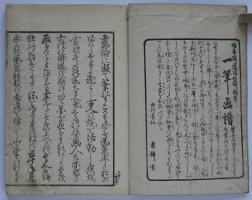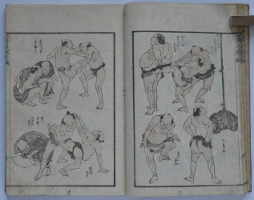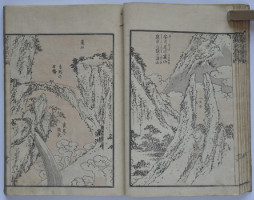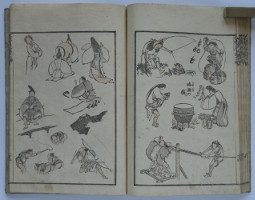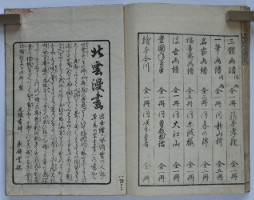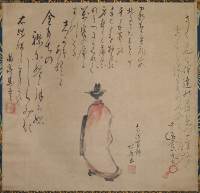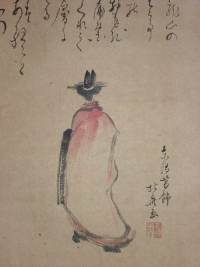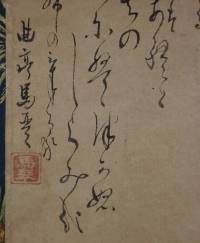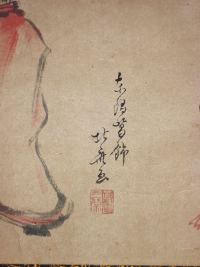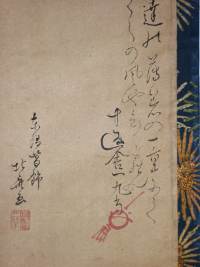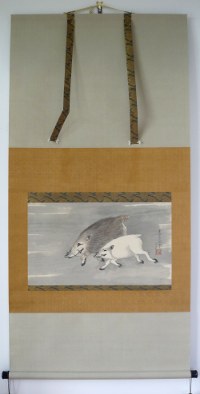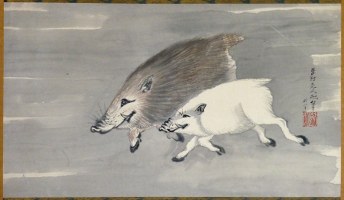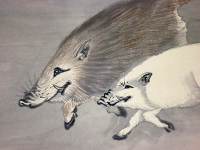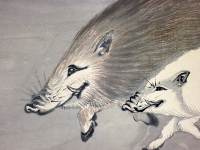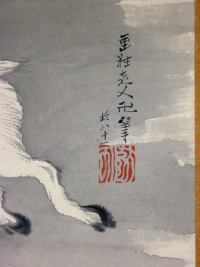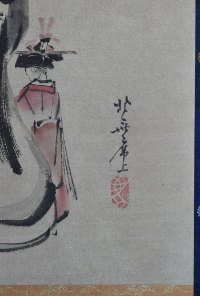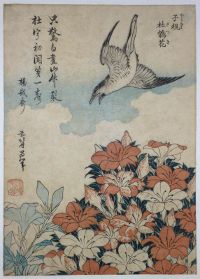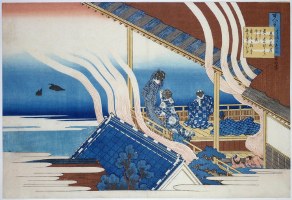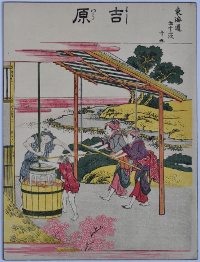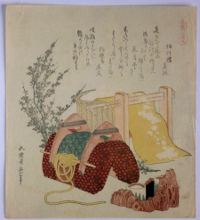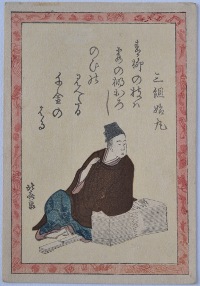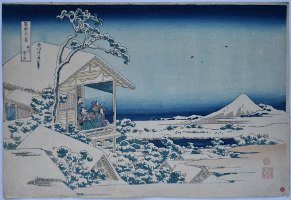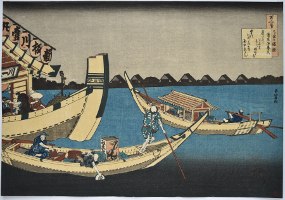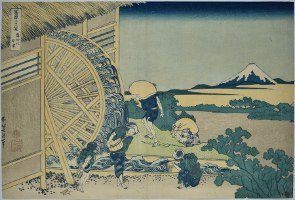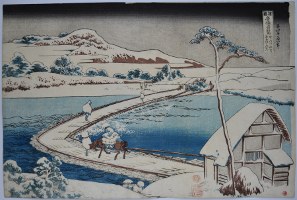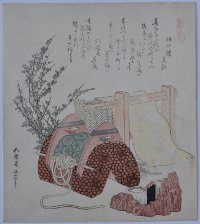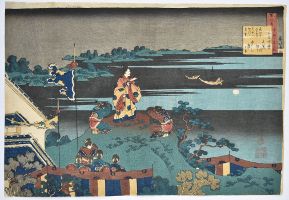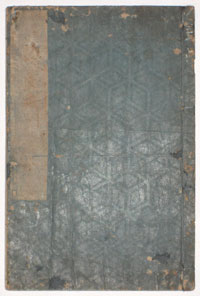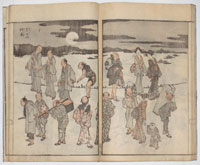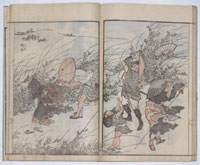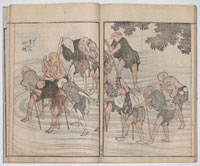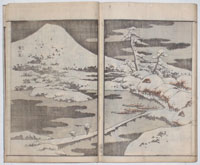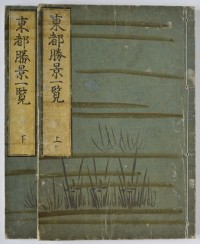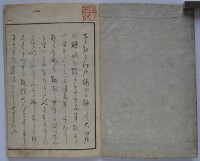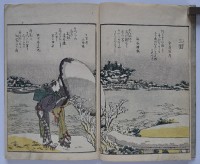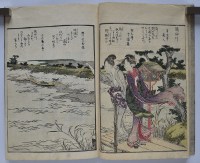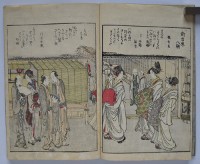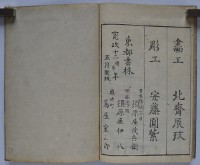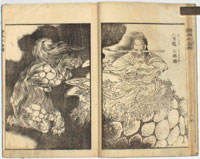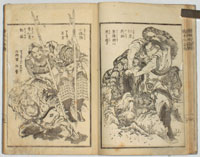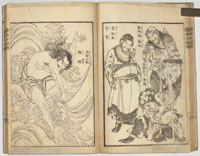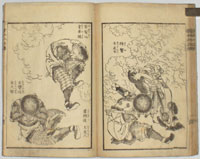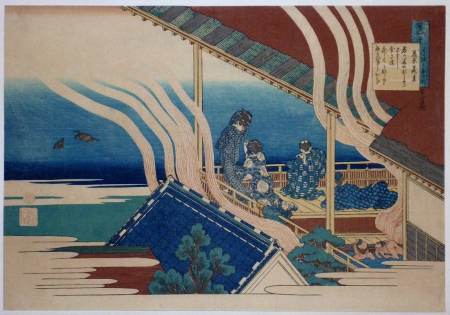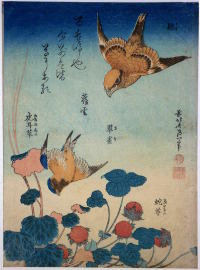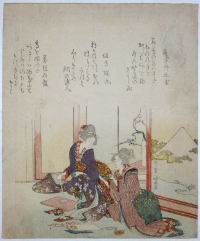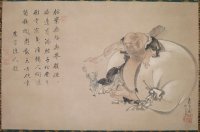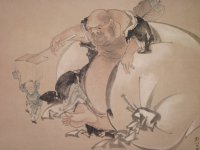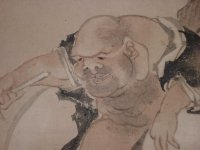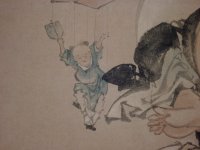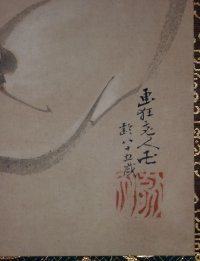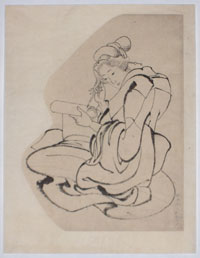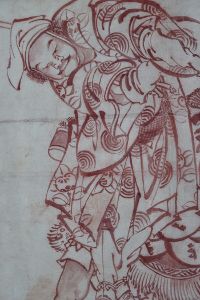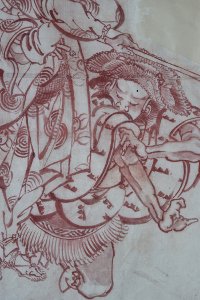Katsushika HOKUSAI (1760-1849)
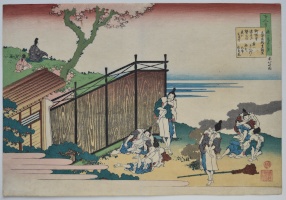
Click here to view image full size.
Hokusai’s interpretation of a poem by Onakatomi no Yoshinobu Ason (921-991). From an unfinished set: Hyakunin isshu uba ga etoki, “Pictures of One Hundred Poems by One Hundred Poets Explained by the Nurse.” The poems are from an anthology Hyakunin isshu, “One Hundred People, One Poem Each” compiled by the poet Fujiwara no Teika (1162-1241). The poet speaks of his love as being like the fire kept by the guards at the gate to the Imperial Palace: It burns hot only at night. There is actually some doubt that the poem can be attributed to Yoshinobu. Shows a group of off-duty Imperial carriage guards relaxing around the smoking embers of a fire. The poet with his servant is seen sitting on the distant hill. Published by Eijudo, 1835-36. A considerable number of original drawings exist for the set that were not turned into prints and are in various museums and private collections.
Fine impression, colour and condition. Signed Saki no Hokusai Manji.
Status: Available
Katsushika HOKUSAI (1760-1849)
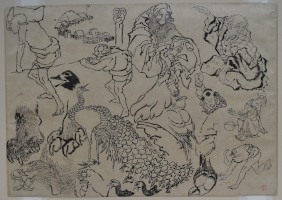
Click here to view image full size.
A sheet of original studies, sumi on thin paper, 10.5 x 15 in; 26.6 x 38 cms. Of particular interest and importance is the self-portrait in the upper right, This is another version of the famous self-portrait at the age of 83 (1842) sent to his publisher. Illustrated in Hokusai Drawings, J. Hiller, Phaidon, 1966, ill. No. 110 from the Rijksmuseum voor Volkenkunde, Leiden, Netherlands. Provenance: Ex Henri Vever collection, seal bottom right.
One small wormhole, otherwise in very good condition.
Status: Available
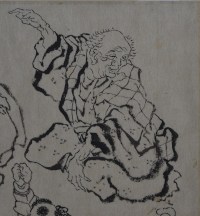
Click here to view image full size.
Katsushika HOKUSAI (1760-1849)
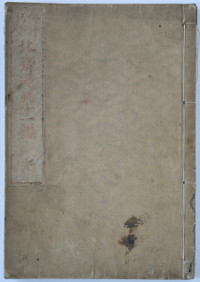
Click here to view image full size.
Volume 11 from the Manga. Front cover with original pink title slip: (Denshin kaishu) Hokusai manga juichihen, (“Transmitted from the Gods.”) “Hokusai’s Sketches, Vol. 11.” Original grey covers with burnished wave and diamond pattern. Inside front cover catalogue of newly published books; 2 pages preface and 29 numbered pages comprising 56 illustrations , 36 single page and 10 double page. 2 pages block-holders catalogue and inside back cover catalogue of newly published books. The extremely rare first edition published by Eirakuya Toshiro, Nagoya, c. 1834. The Manga was eventually completed in 15 volumes (the last two posthumously). The first 10 volumes published by Kadomaruya Jinsuke, Edo and Eirakuya Toshiro, Nagoya, 1814-1819; vols. 11 and 12 by Eirakuya only, c. 1834; vol. 13 by Eirakuya only, c. 1849; vol. 14 by Eirakuya only, c. 1850s; vol. 15 by Eirakuya only, 1878. Initially based on sketches produced on a visit to his friend and pupil Maki Bokusen in Nagoya in 1812. These sketches were collated by Bokusen and Katsushika Hoku’un and published in 1814. Other pupils collected sketches and so the set expanded. The books were enormously influential and popular, not just in Japan, but in the West and were endlessly reprinted giving rise to a plethora of late editions. In 1831, the German Phillip Franz von Siebold, reproduced images from the Manga in lithograph in his Archiv zur Beschreibung von Japon. They were also highly admired by the Impressionists, especially Manet and Bracquemond.
Fine impressions of the first edition. Some minor defects but otherwise in very good condition.
Status: Available
Katsushika HOKUSAI (1760-1849); Kyokutei BAKIN (1767-1848); Jippensha IKKU (1765-1831)
Click here to view image full size.
An original painting by Hokusai showing the back view of a courtesan. Above are inscriptions by Bakin and Ikku, the two leading writers of the day. ( Bakin is famous for writing Chronicles of the Eight Dog Heroes of the Satomi Clan of Nanso and Ikku for writing the most humorous book in the Japanese language: Shank’s Mare Journey on the Tokaido.) This painting was originally sold at the Tokyo Bijutsu Club, December 3rd, 1928. It is illustrated in Katsushika Hokusai Paintings, Mainich Shimbun, 1975. It is signed Toyo Katsushika Hokusai ga, “Painted by Katsushika Hokusai of Orient” and the seal, Katsushika Hokusai, is the same seal as that used on the pair of hand scrolls, Day and Night, in the Museum of Fine Arts, Boston. Colour and sumi on paper, 11.12 x 11.5 in; 28.2 x 29.2 cms. An intriguing old mount and sold with original sales slip from 1928 and a copy of the 1975 catalogue.
The inscriptions translate as:
I went out dressed up very lightly just to show off for the sake of cherry blossom viewing party.
However, I ended up catching a cold and all my efforts to enjoy the cherry blossoms went for nothing.
Jippensha Ikku
Yoshiwara is located in the north of Mount Kinryu, and it is a very grassy place.
Here I live inside the fence of Miuraya,
I am worshiped by so many guests.
Even though I devote myself completely to seek popularity every day,
I am a louse whose heart cannot be stolen by money alone.
This is my mettle as a courtesan.
Kyokutei Bakin
Status: Sold
Katsushika HOKUSAI (1760-1849)
Click here to view image full size.
A small original painting of an old sage (possibly the poet Saigyo Hoshi [1118-1190]) seated, holding a bamboo pole and with a large hat on his back. He looks up wistfully at a mountain range with what appears to be a hanging bridge over a gorge. Light colour on silk; predominantly the pink, brown and sumi tints he was fond of. Image size 7.5 x 5.75 in; 19 x 14.5 cms. Provenance: From the estate of Jeanne Nicole Ledoux, daughter of Jean Pierre Ledoux, who was the son of the famous ukiyo-e collector Louis V. Ledoux. Mounted as a kakemono. In good condition. Signed Hachijukyusai Manji hitsu, “Brush of old man Manji, aged eighty-nine years.” And with seal Hyaku (“Hundred”). A fan painting in the Museum of Fine Arts, Boston, acc. No. 11.7470, has the same seal and signature.
Status: Sold
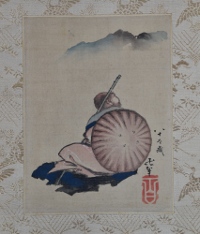
Click here to view image full size.
Katsushika HOKUSAI (1760-1849)
Click here to view image full size.
An original painting by Hokusai showing wild boars, a parent and baby. Another “Wild Boar in the Moonlight” painting is in the Museum of Fine Arts, Boston, acc. No. 11.7430, ex William Sturgis Bigelow collection. The same broad background brushstroke shading is found on both paintings. Illustrated in Idemitsu Museum of Arts, vol. 9, Ukiyo-e Paintings, Kikuchi Sadao, 1976, pl. 84, p. 57. It was originally in the inventory of Yabumoto Soshiro, the largest antique dealer in Tokyo after he moved from Kyoto in the second half of the 20th century. Sumi and light colour on paper, 12.75 x 22 in; 32.4 x 56 cms. Signed Gakyorojin Manji hitsu rei hachi-ju-ichi (“at the age of 81”) with Fumoto-no-saki seal, so probably painted for the year of the boar, 1839. There are other paintings with the same signature and seal, e.g. The Harari Collection of Japanese Paintings and Drawings, volume 2, Jack Hillier, Lund Humphries, 1970, no. 142 “The Comet,” p. 258.
In very good condition. Recently remounted and sold with the old Edo-era box.
Status: Sold
Katsushika HOKUSAI (1760-1849)
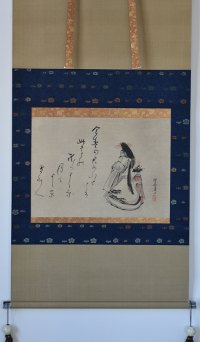
Click here to view image full size.
An original painting showing the back view of a courtesan and her assistant. The poem is by Shokusanjin:
It is all because of you who is blooming,
flowers and the moon in this quarter seem prosperous
Shokusanjin
This appears to have been painted during his Sori period at a banquet held by the geisha house that Hokusai and Shokusanjin attended. In good condition having been recently remounted. Sumi and light colour on paper, 15.25 x 21.5 in; 38.7 x 54.6 cms. Signed Hokusai sekijyo, “Hokusai on this occasion.”
Seal unread: This is a seal used by Hokusai during this period as well as in his later years, but has not been deciphered.
Status: Sold
Katsushika HOKUSAI (1760-1849)
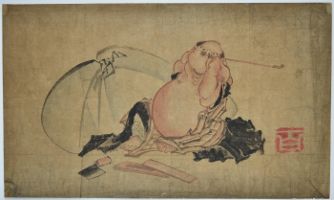
Click here to view image full size.
An original painting showing Hotei, the God of happiness and one of the Seven Gods of Good Luck (Shichi-fuku-jin). The corpulent Hotei reclines contentedly smoking a long pipe. Beside him is his huge bag (hotei literally means “cloth bag”) which contained the treasures and food he dispersed. Sumi and light colour on paper, 15.25 x 9 in; 38.5 x 23 cms. Presumably from a hand scroll. A spurious Hokusai seal to the right. Paper browned and soiled. Sold “as is” with all imperfections.
Status: Sold
Katsushika HOKUSAI (1760-1849)
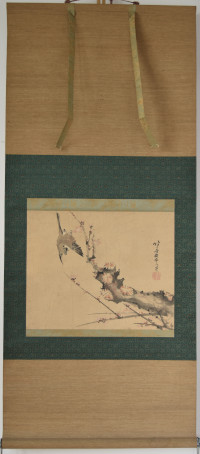
Click here to view image full size.
An original painting, light colour on paper, 13 x 16.5 in; 33 x 42 cms. Shows a sparrow flying over a flowering plum tree. Light soil and creasing, but in generally good condition. Signed Hokusai suichu hitsu, “Hokusai painted while drunk.” Sealed Katsushika. (One of his better-known seals. He used different versions of it throughout his career.)
Status: Sold
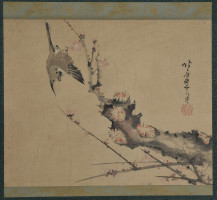
Click here to view image full size.
Katsushika HOKUSAI (1760-1849)
Click here to view image full size.
Cuckoo and azaleas from the so-called Small Flower series of ten chuban prints published c 1832. Amongst the most sought after of Hokusai’s prints. The first edition was published by and has the seal Eijudo. A later edition (as here) has combined manji and kiwame seal ( and some are printed on thin Chinese-style paper ), and there are also impressions extant without any seals which probably constitute a third state. All impressions are rare and the first state excessively so. Indeed, these prints are considered even rarer than the larger bird and flower set Hokusai designed c 1833. The printing and colour on this set comes close to surimono quality. Each print has a Chinese poem written in hiragana.
Fine impression. Slight fading, otherwise very good condition. Signed Zen Hokusai Iitsu hitsu.
Status: Sold
Katsushika HOKUSAI (1760-1849)
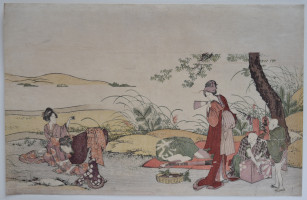
Click here to view image full size.
A group of three women picking mushrooms. Published c 1800. Another impression, from the Musee Guimet, is illustrated in Muneshige Narazaki, Ukiyo-e Masterpieces in European Collections, 6, Musee Guimet, Paris, 1, p. 176, no. 90.
Fine impression. Very good colour and condition. Unsigned.
Status: Sold
Katsushika HOKUSAI (1760-1849)
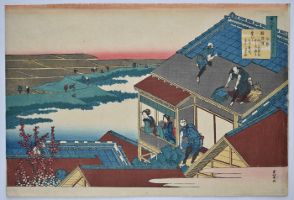
Click here to view image full size.
A design interpreting a poem by the Lady of Ise (c. 875-c. 938) from an unfinished set Hyakunin isshu uba ga etoki, “The Hundred Poems [By the Hundred Poets] as Told by the Nurse.” Published 1835-36 by Eijudo with 27 prints known and 67 outstanding drawings for the set. Shows a mother and daughter or lady and servant at a window overlooking Naniwa Inlet with rice fields in the distance and men working on the roof of the building they are in.
Fine early impression with woodgrain showing on the roof. Fine colour. Small nick out of right edge, otherwise fine condition. Signed Zen Hokusai manji.
Status: Sold
Katsushika HOKUSAI (1760-1849)
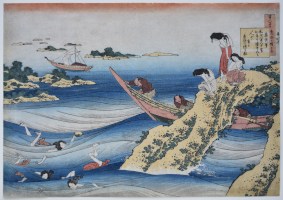
Click here to view image full size.
Hokusai’s interpretation of a poem by Ono no Takamura (802-852). From an unfinished set: Hyakunin isshu uba ga etoki, “Pictures of One Hundred Poems by One Hundred Poets Explained by the Nurse.” The poems are from an anthology Hyakunin isshu, “One Hundred People, One Poem Each” compiled by the poet Fujiwara no Teika (1162-1241). The poem was composed on the eve of Takamura’s banishment to an isolated island, later to be pardoned by the Emperor. (His boat can be seen in the distance.) One of Hokusai’s most beautiful prints showing women divers (ama) fishing for abalone (awabi). The divers are seen between waves reminiscent of a Victorian theatre stage set. Published by Eijudo, 1835-1836. A considerable number of original drawings exist for the set that were not turned into prints and are in various museums and private collections.
Fine impression and colour. Very slight edge soil, otherwise very good condition. Signed Saki no Hokusai.
Status: Sold
Katsushika HOKUSAI (1760-1849)
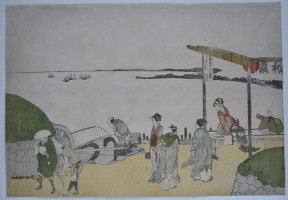
Click here to view image full size.
A street scene with travellers, an ox cart and a teahouse at the Okido gate, Takanawa, in Edo bay to the south-east of Edo. This stretch of coast leading to Shinagawa was lined with stalls and restaurants and very popular. The gate – the stone remains of which can be seen on the left and right – was the last travellers passed through on the Tokaido road to Edo. Another impression is in MFA Boston (21.10262, ex Spaulding via Frank Lloyd Wright) and a third in the BM (1937-0710-0-209).
Fine impression, colour and condition.
Status: Sold
Katsushika HOKUSAI (1760-1849)
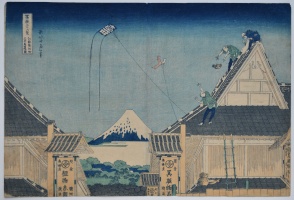
Click here to view image full size.
New Year’s Day with a view of Mount Fuji seen down Suruga Street with the Echigoya Mitsui store on the left and right. Edo Surugacho Mitsui mise ryakuzu, “The Mitsui Shop at Surugacho, Edo.” From Hokusai’s most famous set: Fugaku sanjurokkei, “Thirty-six Views of Fuji.” Surugacho district was located just north of Nihonbash Bridge. One of the largest stores was the Echigoya Mitsui Clothing Store, now known as Mitsukoshi. On the left a sign states that the store sells braided cords and threads, and on the right that it sells clothing. It also announces that it takes cash payment: The store was the first to adopt cash payment at the point of sale, rather than billing clients once or twice a year, hence they could cut their prices. The set published 1830-34 by Nishimuraya Yohachi. There are variant states of this design with the blue wiped across the top of the design only, wiped top and at horizon and wiped at top with the entire sky printed blue (as here). This is the earliest version.
Very fine early impression. Fine colour. Slight centre fold, otherwise fine condition. Full, untrimmed size. Signed Zen Saki no Hokusa aratame hitsu.
Status: Sold
Katsushika HOKUSAI (1760-1849)
Click here to view image full size.
A poem by Fujiwara no Yoshitaka (954-974) from Hyakunin isshu uba ga etoki, the “Hundred Poems Explained by the Wet Nurse.” Published by Eijudo and Iseri, c 1835-6. Although obviously intended to be a set of 100 prints, only 27 are known plus drawings for others. The poet speaks of a trivial life prior to meeting his lover. Two women and their companions relax after a bath admiring the view across water. Steam rises from the bath and two cormorants are seen on the left. A languid scene and one of Hokusai’s most beautiful designs.
Fine impression. Very good colour. Two states are known: the printers quickly discovered that the red seal at left was not easily discernible and cut the block to correct this. This is the first state but the seal can hardly be seen except on the reverse. Signed Zen Hokusai.
Status: Sold
Katsushika HOKUSAI (1760-1849)
Click here to view image full size.
Yoshiwara Station from a chuban Fifty-three Stations of the Tokaido. The set of 55 prints published by Iseya Rihei, c 1806. Unsigned but the original wrapper evidently had Hokusai’s signature. Two women, a man and boy press grapes.
Fine impression. Extremely fine colour. One small repaired wormhole near edge, otherwise fine condition.
Status: Sold
Katsushika HOKUSAI (1760-1849)
Click here to view image full size.
A surimono, Watakuri uma, from a series Uma tsukushi, “Horse Series.” The set of at least thirty surimono was issued by the Yomo-gawa Poetry Club for the Horse Year, 1822. The title alludes to the appearance of the watakuri, “cotton gin” usually seen atop a wooden sawhorse-like stand. Also shown is a wooden saddle on a leather base, a smoking set and branches of white plum. Poems by Matsuchi, Kagetsudo and Matsunoya Sononari. Rare.
Fine impression and colour with silver, gold and blind-printing. Very good condition. Signed Fusenkyo Iitsu hitsu.
Status: Sold
Katsushika HOKUSAI (1760-1849)
Click here to view image full size.
A koban surimono from a kyoka set ( of one hundred ? ) published c. 1805. Shows a kyoka poet with poem by Mikumi Himemari. Seemingly the only large group illustrated is in the Katsushika Hokusai Exhibition from The Peter Morse Collection, Ukiyo-e Ota Memorial Museum of Art, 1988, no . 167 ( this design on page 106 ). Rare. Ex collection Tony Strauss-Negbaur ( seal au verso ).
Fine impression, colour and condition. Signed Hokusai ga.
Status: Sold
Katsushika HOKUSAI (1760-1849)
Click here to view image full size.
Koishikawa yuki no ashita, “Snowy Morning at Koishikawa” from Hokusai’s most celebrated set: Fugaku sanjurokkei, the “Thirty-six Views of Mount Fuji.” The set of 46 prints published by Eijudo, c. 1830-32. Shows a party at a teahouse, at left, admiring the view of Fuji. The only snow scene from the set. Provenance: Ex Le Veel collection, sold by Ader Picard Tajan, Paris, 2nd sale, 24/10/1980, lot 76, p. 36.
Exceptionally early impression (blue outline). Fine colour and, apart from slight vertical crease, fine condition. Very full size with extra paper top and right. This design usually has a clear sky with blue gradation at top and horizon. This state with a subtly graded blue sky appears to be the earliest version (with other similar impressions in the BM [1927.0613.0.13] and MET [JP1330]). Not only does it better convey the wintry conditions but Eijudo was probably also conscious of saving money on this expensive pigment on later editions. The finest example to come onto the market for many years. Signed Zen Hokusai Iitsu hitsu.
Status: Sold
Katsushika HOKUSAI (1760-1849)
Click here to view image full size.
A summer night on the Sumida river, Edo, illustrating a poem by the 9th – 10th century poet Kiyowara no Fukayabu. From the set: Hyakunin isshu uba ga etoki. “The Hundred Poems by a Hundred Poets Explained by a Nurse. Twenty seven published designs are known for this set with another sixty two preparatory drawings extant. The set was curtailed probably due to the adverse economic climate at the time. It was started by the publisher Nishimuraya Yohachi (Eijudo) who published five, c 1835-6, and then taken over by Iseya Sanjiro (another Eijudo) who published the other twenty two. This design might be the first of the Iseya Sanjiro prints as it has the word shimpan on the lanterns meaning “new.” Shows a large boat, left. Probably a floating restaurant with another smaller vessel in the centre purveying food.
Fine impression. Slight fading of the red block. Fine condition. Signed Zen Hokusai manji.
Status: Sold
Katsushika HOKUSAI (1760-1849)
Click here to view image full size.
Onden no suisha, “Waterwheel at Onden” from the set Fugaku sanju-rokkei, the “Thirty-Six Views of Fuji.” The series published by Eijudo between 1829-33 and extended to forty six prints. These extra designs have a black outline, whereas the first thirty six have blue outlines in the early editions and then black. Shows the mill with men carrying bags of rice to be milled. A woman washes vegetables, another carries a tub and a small child drags a terrapin. Onden was on the Shibuya river, between Harajuko and Aoyama. (The river now hidden from view under the concrete sprawl of Tokyo.) Evidently waterwheels dotted the area powered by the Shibuya river.
Fine impression and colour. (Collectors are often unaware that designs from this set are faded: The yellow part of the green fades, leaving blue. And because there are designs that are only printed in blue or are blue in the early states, they accept them as unfaded.) Trimmed left and top and slight centre fold, otherwise very good condition. Signed Zen Hokusai I-itsu hitsu.
Status: Sold
Katsushika HOKUSAI (1760-1849)
Click here to view image full size.
Kozuke Sano funabashi no kozu, “Old View of the Pontoon Bridge at Sano, Kozuke Province.” From a set of eleven prints, Shokoku meikyo kiran, “Wondrous Views of Famous Bridges in All the Provinces.” A snow scene showing travellers, one on horseback, traversing the pontoon bridge built of boats. Published by Nishimuraya Yohachi, 1831-2.
Very good impression. Some slight fading. Very good condition. Full size. Signed Zen Hokusai Iitsu hitsu.
Status: Sold
Katsushika HOKUSAI (1760-1849)
Click here to view image full size.
A surimono, Umazakushi, showing a saddle and cotton-gin from Watakuri uma, “A Series of Horses.” Issued for the Yomogawa club, 1822. Shows a horse’s saddle, a cotton-gin, basket of cotton floss and a branch of plum. A smoking set in the foreground. This set followed on from the success of the Shell surimono series issued in 1821. Twenty eight designs are known. The title (in a red gourd) top right is hand-stamped. Rare.
Fine impression with silver, gold and blind-printing. Fine colour. Minor soil, otherwise very good condition. Signed Fusenkyo Iitsu hitsu.
Status: Sold
Katsushika HOKUSAI (1760-1849)
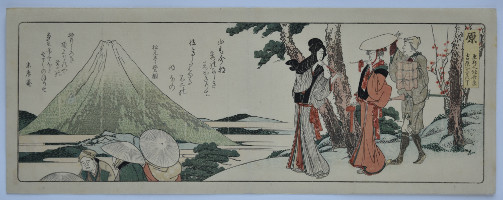
Click here to view image full size.
A surimono, Hara, from an untitled Tokaido set, generally called the Surimono Tokaido. Published in 1804 for a kyoka club. There are 59 prints in the set; 8 being in this horizontal tanzaku format, the rest being koban size. This is the very rare first edition with the kyoka poems. In the second edition, also in 1804, the poems are left out. There is also a third edition in 1805 and a fourth in the 1840s where these tanzaku designs were replaced by koban prints designed by Hokusai’s pupil Yanagawa Shigenobu. Shows travellers admiring Fuji.
Very fine impression. Fine colour and condition. Signed Gakyojin Hokusai ga.
Status: Sold
Katsushika HOKUSAI (1760-1849)
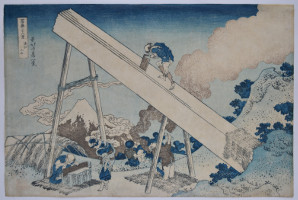
Click here to view image full size.
Totomi sanchu, “In the Totomi Mountains” from Hokusai’s most famous set Fugaku sanju-rokkei, “Thirty-six Views of Fuji.” The set published by Nishimuraya Yohachi c. 1830-33. Originally planned as a set of 36 prints, ten more designs were added. These are called the Ura-Fuji, “Fuji from the Other Side.” These designs have a black outline, while early impressions of the first 36 are printed with a blue outline changing to black on later editions. Shows lumbermen cutting a huge log while another, lower left, sharpens a saw watched by a woman with a child strapped to her back. This set was a considerable undertaking for the publisher, especially as the relatively new pigment berurin burau, “Berlin blue” was being used which was expensive.
Very good impression, colour and condition. Very full size. Signed Saki no Hokusai Iitsu hitsu.
Status: Sold
Katsushika HOKUSAI (1760-1849)
Click here to view image full size.
A poem by Abe no Nakamaro from the unfinished set Hyakunin isshu uba ga etoki, “Hundred Poems Explained by the Wet Nurse.” Twenty seven prints known with extant drawings for another sixty two. Published in 1835 by Nishimuraya Yohachi (who issued five) who then sold the blocks to Iseya Sanjiro. Shows the poet on a mount with Chinese soldiers waiting to take him away and imprison him. An unconventional interpretation of the poem which has Nakamaro left in a high pagoda to starve to death for attempting to steal the secrets of the Chinese calendar. He gazes at the moon (seen here reflected in the sea) and asks if it’s the same moon as that rising over his homeland – Japan.
Fine impression, colour and condition. Signed Zen Hokusai with Manji seal. As with others in this set, the signature is near the extreme edge and is often trimmed off.
Status: Sold
Katsushika HOKUSAI (1760-1849)
Click here to view image full size.
One volume complete: Hokusai soga, “Hokusai’s Free Sketches.” Two versions of this publication are known: Solely printed in sumi and ( as here ) sumi with gradated shading and a pink block. This version also with the colophon. Both are almost certainly contemporaneous. Contain’s some of Hokusai’s best known images and was considered by Jack Hillier to contain “the finest figure prints by Hokusai.” Published 1820 by Eirakuya, Nagoya; Surawaya Mohei and seven others in Edo.
Original light blue burnished covers. Original title slip. Some slight damage to covers, and thumbing on some pages, but overall a very nice copy with fine impressions.
Status: Sold
Katsushika HOKUSAI (1760-1849)
Click here to view image full size.
Two volumes complete: Toto shokei ichiran, “Fine Views of the Eastern [Edo] Capital at a Glance.” Shows famous places in Edo with accompanying kyoka poems at the top. Volume 1: 10 sheets, 1 p. preface. Volume 2: 11 sheets with colophon giving date Kwansei 12 (1800). Publishers Tsutaya Jusaburo, Suharaya Mohei and Suharaya Ihachi. Ando Enshi engraver and artist Hokusai shinsei. This book was first published with title Toto meisho ichiran by Tsutaya Jusaburo. Shortly afterwards the title was changed and the two other publishers joined Tsutaya Jusaburo. This is the edition offered here. Original hand-painted covers with a decoration of iris flowers and water (only found on the original edition). The blocks were subsequently sold to the Nagoya publisher Hishiya Kinbei who reissued it in 1815 together with Suharaya Mohei and Ihachi. The blocks were yet again sold, this time to Kawachiya Mohei who issued another reprint in 1840 with the above publishers. A lovely early example of this famous book. Cover and title slips in very good condition.
One wormhole affecting last 4 pages at the top outside image area, otherwise contents fine and clean. Provenance: Large seal of Hayashi Tadamasa at the start to each volume.
Status: Sold
Katsushika HOKUSAI (1760–1849)
Click here to view image full size.
One volume complete Ehon Suikoden, “A Picture Book of the Suikoden”, published by Kadomaruya Jinsuke, Bunsei 12, 1829 showing 108 Chinese brigands. Some fine designs. Signed Katsushika Zen Hokusai I-itsu fude.
Fine impressions. Original covers lacking title slip. Some slight foxing and minor marks.
Status: Sold
Katsushika HOKUSAI (1760-1849)
Click here to view image full size.
A poem by Fujiwara no Yoshitaka (954-974) from Hyakunin isshu uba ga etoki, the “Hundred Poems Explained by the Wet Nurse.” Published by Eijudo and Iseri, c 1835-6. Although obviously intended to be a set of 100 prints, only 27 are known plus drawings for others. The poet speaks of a trivial life prior to meeting his lover. Two women and their companions relax after a bath admiring the view across water. Steam rises from the bath and two cormorants are seen on the left. A languid scene and one of Hokusai’s most beautiful designs.
Fine impression, colour and condition. Full size. Two states are known: the printers quickly discovered that the red seal at left was not easily discernable and cut the green block to correct this. Signed Zen Hokusai.
Status: Sold
Katsushika HOKUSAI (1760-1849)

Click here to view image full size.
A matron with lover. A shunga sheet from the extremely rare de-luxe edition of the Fukujuso, “The Adonis Plant.” The blocks were re-carved, the text deleted, a mica ground added, and sumptuous hand-colouring applied and was renamed Nami chidori, “Plovers Above the Waves.” This was a costly exercise and was obviously directed at a few wealthy clients. Hokusai’s best shunga set with large figures often completely filling the space. Published c 1820. Another example illustrated in Richard Lane, Hokusai, Life And Work, Barrie & Jenkins, 1989, no. 224, p. 168.
Fine impression. Wonderful fresh carefully hand-applied colour with mica ground. Album backing. Centre fold (as usual) and slight soil to corner. But otherwise very good condition.
Status: Sold
Katsushika HOKUSAI (1760-1849)
Click here to view image full size.
One sheet from a shunga set of 12 prints Ehon tsuhi no hinagata, “Patterns of Loving Couples.” Published 1814. The series title is a play on words. Tsuhi can be read as “couple” or “male and female pairs” or it can be pronounced tsubi, an old term for vulva.
Very good impression and colour. Slight soil and the usual slight centre fold, otherwise very good condition.
Status: Sold
Katsushika HOKUSAI (1760-1849)
Click here to view image full size.
One sheet from a shunga set of 12 prints Ehon tsuhi no hinagata, “Patterns of Loving Couples.” Published 1814. The series title is a play on words. Tsuhi can be read as “couple” or “male and female pairs” or it can be pronounced tsubi, an old term for vulva.
Very good impression and colour. Slight soil and the usual slight centre fold, otherwise very good condition.
Status: Sold
Katsushika HOKUSAI ( 1760-1849 )
Click here to view image full size.
Shrike and wild strawberry from the so-called Small Flower series of ten chuban prints published c 1832. Amongst the most sought- after of Hokusai’s prints. The first edition ( as here ) was published by and has the seal Eijudo. A later edition has combined manji and kiwame seal ( and some are printed on thin Chinese-style paper ), and there are also impressions extant without any seals which probably constitute a third state. All impressions are rare and the first state excessively so. Indeed, these prints are considered even rarer than the larger bird and flower set Hokusai designed c 1833. The printing and colour on this set comes close to surimono quality. Each print has a Chinese poem written in hiragana.
Fine impression and colour. Minor soil, otherwise very good condition. Signed Zen Hokusai Iitsu hitsu.
Status: Sold
Katsushika HOKUSAI ( 1760-1849 )
Click here to view image full size.
A surimono showing two young girls making new year envelopes. On the side screen is a view of Fuji. Three poems above. Published c 1806.
Fine impression and colour. Small strengthened area au verso, otherwise very good condition. Signed Hokusai ga.
Status: Sold
Katsushika HOKUSAI ( 1760-1849 )
Click here to view image full size.
Hotei with a karako puppet doll. Hotei, the God of abundance and good health, was one of the Seven Gods of Good Luck. The concept originated in India ( except Ebisu ) and came to Japan via China. He is usually shown as a shaven-headed priest in loose Chinese garments, holding a fan and reclining against a large bag. He is often surrounded by children trying to discover what is in the bag. Karako is a Chinese child who is usually depicted with a partly shaven head. These “treasures” were auspicious symbols of prosperity. Sumi and light colour on paper, image size 20.75 in x 13.5 in; 52.6 cms x 34.4 cms. The calligraphy is by Shotochinjin. Signed Gakyo Rojin Manji yowai hachi-go, “From the brush of Manji, old man mad with painting, aged eighty-five. With Katsushika seal. Exhibited in Masterpieces of Paintings by Hokusai School at the Itabashi Art Museum, 2008. . New mount and box with a futo-maki ( a thick wooden roll to preserve the painting from damage ). In fine condition.
Status: Sold
Katsushika HOKUSAI (1760-1849)
Click here to view image full size.
An original sumi drawing of a seated bijin writing on a handscroll. From a series of such studies showing women in various attitudes, smoking; playing musical instruments; adjusting hair, etc. The design cut out and mounted onto a larger sheet of Japanese paper, 10.5 x 8 inches.
Status: Sold
Katsushika HOKUSAI (1760-1849)
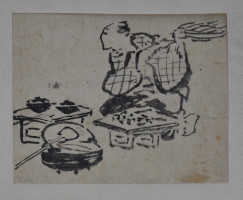
Click here to view image full size.
A small original drawing, 3.25 x 4.25 in; 0.825 x 1.05 cms. Sumi on paper laid onto card showing a vendor or waiter offering food. Very much in the style of the “Day” and “Night” series of drawings in the MFA, Boston, c 1815. Provenance: Ex collection Catherine Gide, the daughter of Andre Gide and Elizabeth van Rysselberghe who was the daughter of Theo van Rysselberghe, the Belgian painter and friend of the French Impressionists. Sold “as is.”
Status: Sold
Katsushika HOKUSAI (1760-1849)
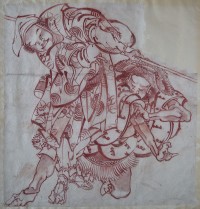
Click here to view image full size.
An important large brush drawing in red ink showing a full length figure wielding a stave at a cowering adversary. The standing figure has no sword or armour but is obviously a chivalrous man of great probity. The leaning attitude of the upright figure is typical of Hokusai (for example, see Theodore Bowie, Indiana University Press, 1974, The Drawings of Hokusai, no. 108) and gives movement to what otherwise would be a static pose. Red ink was frequently used by Hokusai, not just on the obvious Shoki paintings (see nos. 160-161, pages 254-5, Timothy Clark, Hokusai Beyond The Great Wave, B.M., 2017) but as underdrawing on figures and landscapes (see nos. 178-182, pages 279-283, Timothy Clark, Hokusai Beyond The Great Wave, B.M., 2017). Red ink and wash on thin Japanese paper laid onto european paper, image area 16.5 x 15.5 in; 41.5 x 39.5 cms. An area not pertinent to the design missing top right but otherwise in good condition. Provenance: Ex collection of Peggy and David Rockefeller (inventory number 23.040).
Status: Sold
